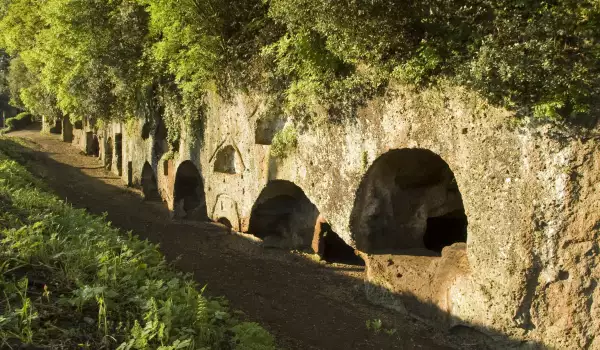Etruscan Tombs Cerveteri

Etruscan Tombs Cerveteri is located in southern Etruria, 50 km northwest of Rome. Through its ports Pyrgi, Alzium and Punikum, the town acquired importance as a trading center.
The Etruscan name is interpreted in different ways - Cisra, Kaysra, etc. In Phoenician tray of Pyrgi, the city is listed as Kisri. Etruscan tombs Cerveteri included in the UNESCO list of world cultural heritage sites.

The earliest data of Cerveteri dates from 9-8 century BC, and wears characteristics of the given period. At least two villages were founded during this period, as can be deduced from the funeral urns in the oldest cemetery - Sorbo.
In 253 BC. Cerveteri appears in confrontations against Rome. The Etruscan city was defeated and lost part of its territory, including the coast. Deprived of its ports, it is doomed to a permanent crisis, which leads to total destruction during the 1 century BC.
Historically, the city covers about 150 hectares, compared with the modern city, which occupies only one third of that space. In places the rocks reach up to 50 m in height and form a basic protection, but in areas where they became lower or disappeared, were built walls.
Etruscans in Cerveteri built a remarkable road network, connecting their cities and most of the roads are developed by the Romans and used to this day. Via Clodia and initial part of the Via Aurelia were first built by the Etruscans. In the area of the city were no proper excavations, but only partial studies in the region and sports field, where found were traces of a temple of Hera.
The large number and wealth of the tombs also indicate a high development of the city. Cerveteri has five necropolises - Sorbo, Monte Abatone, Cava Potsolana, Gropie di San Antonio and Banditacha, where they found more than 400 tombs, the formation of real streets of the dead, covered with volcanic tuft. Most of the tombs can be dated between 7 and 6 century BC. The most common are those with an underground chamber and tumulusite in which the inner rooms imitate Etruscan homes.
In Cerveteri, we can see the Tomb of Regolith-Gallas, located in the necropolis Sorbo and opened in 1836 by Archbishop Regolith and General Gallas. Tomb Trap is located in the necropolis Tumulus II Banditacha. The tomb with a painted lion, dating from the third quarter of 7 th century BC. Its name comes from the frescoes found inside. Tomb of capital is of the first half of the 6 th century BC.
Tomb of Greek vases is located in Tumulus II in the necropolis of Banditacha, along with Tomb Trap and two others. Tomb with shields and thrones dates from 520-500 BC. and is located in the same tumulus as the Tomb of lions. Tomb with Reliefs was discovered in 19 century by the Marquis Campana and its interior is protected by a special glass door.
The tomb was dug to a considerable depth into the ground. It is one of the few that keeps the colors of the frescoes, since artists used clay to form reliefs, thus they have become the basis of the mural.
Treasures in the tombs include many bronze and silver items, fine gold jewelry, vases produced locally, including the famous "Bucchero" and others imported from Greece, ceramics, including lighting figures.
The richness of funerary objects from Cerveteri is legendary, but the content is exposed in the Vatican Etruscan Museum. It was opened in 1837 under the name Grigorian Etruscan Museum. The main part of the collection are the original finds from archaeological excavations conducted in Cerveteri from 1828 to 1837.















